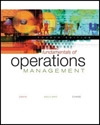 |  Fundamentals of Operations Management, 4/e Mark M. Davis,
Bentley College
Nicholas J. Aquilano,
University of Arizona
Richard B. Chase,
USC, School of Business
Feature Summary- Chapter objectives. At the beginning of each chapter, a list of objectives is presented to highlight the important concepts on which the chapter focuses.
- Vignettes. Each chapter begins with a short vignette that shows how the chapter topic is actually applied in a real-world setting, to create student interest for the chapter material.
- Application of OM concepts. Examples of how many of the OM concepts presented in this text are applied in actual business situations are provided throughout the text. The use of real-world examples reinforces the critical role of operations management, showing how it contributes to the overall success of an organization. These applications take several forms, including the opening vignette to each chapter and Operations Management in Practice boxes, as well as in the numerous examples that are included throughout the text itself.
- Internet exercises. The Internet continues to be a powerful tool for obtaining and disseminating information, and this information is constantly changing. Where appropriate, an Internet exercise is provided at the end of a chapter to encourage students to obtain the latest information on a particular topic.
- The application of Excel® spreadsheets. Again, where appropriate, examples are provided using Excel® spreadsheets that encourage the student to explore alternative solutions.
- Highlighting links with other functional areas. Ideas and processes flow easily across traditional functional boundaries in successful organizations, often to the point where it is practically impossible to determine where one function leaves off and another begins. To emphasize this integration within organizations, icons are used throughout the text to highlight examples of how OM is linked to other functional areas.
- Global perspective. Another emphasis of the book is a stress on the global impact of operations today; where appropriate, we show how the concepts apply in a global context. Special icons are used in the book to highlight this area.
- Margin definitions. Key terms are in boldface when first defined and definitions added in the margin. At the end of the chapter these key terms are listed with page numbers for quick student reference.
- Full-color art. This fourth edition includes photos and exhibits to enhance the visual appeal and interest of students, to clarify and extend the text discussions, and to help students see operations in action.
- Examples with solutions. Examples follow quantitative topics and demonstrate specific procedures and techniques. These are clearly set off from the text and help students understand the computations.
- Formula review. Key formulas and equations are numbered within each of the more quantitative chapters and are repeated in summary form at the end of those chapters for easy student review.
- Solved problems. Representative example problems are included at the end of appropriate chapters. Each includes a detailed, worked-out solution and provides another level of support for students before they try homework problems on their own.
- Review and discussion questions. These questions allow students to review the chapter concepts before attempting the problems and provide a basis for classroom discussion. Suggested responses are included in the Instructor's Manual.
- Problems. A wide range of problem material follows each chapter, asking students to solve realistic, interesting problems.
- Cases. Located at the end of most chapters, short cases allow students to think critically about issues discussed in the chapter. These also can provide good classroom discussions or provide a capstone problem for the chapter. We've included both long and short cases such as Kristen's Cookie Company from Harvard.
|
|




 2002 McGraw-Hill Higher Education
2002 McGraw-Hill Higher Education


 2002 McGraw-Hill Higher Education
2002 McGraw-Hill Higher Education